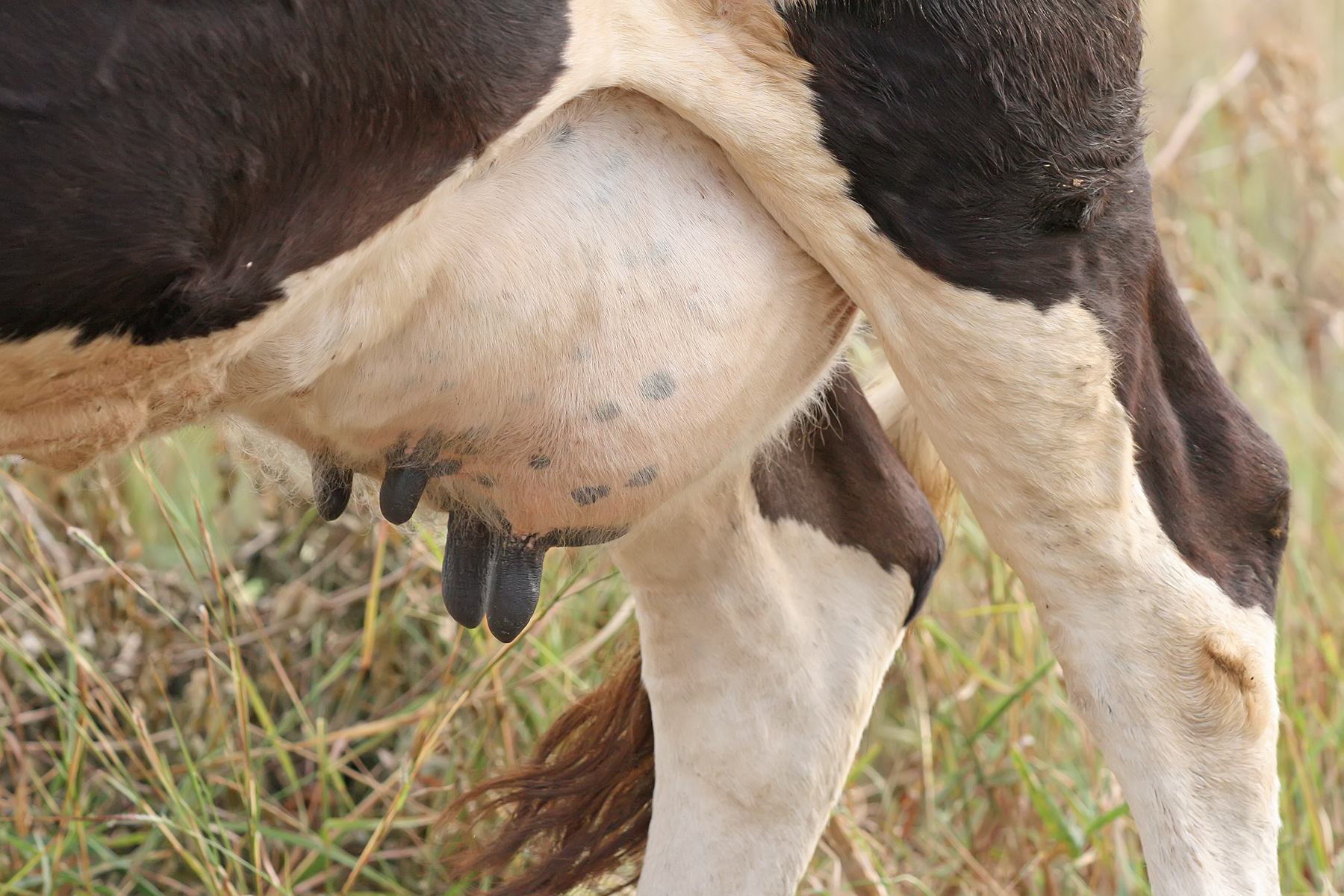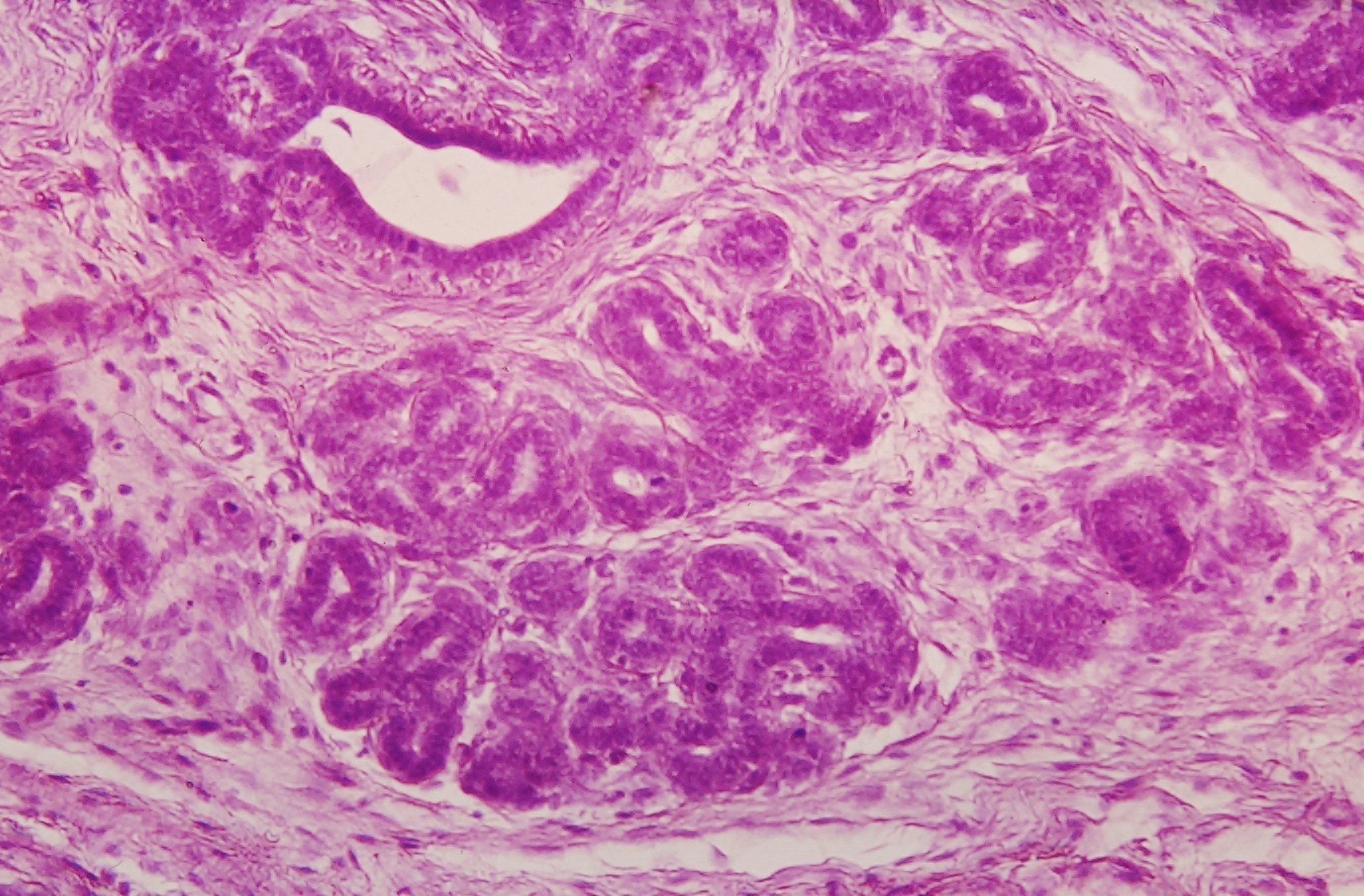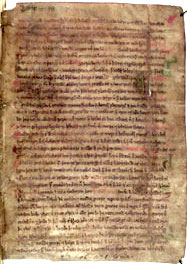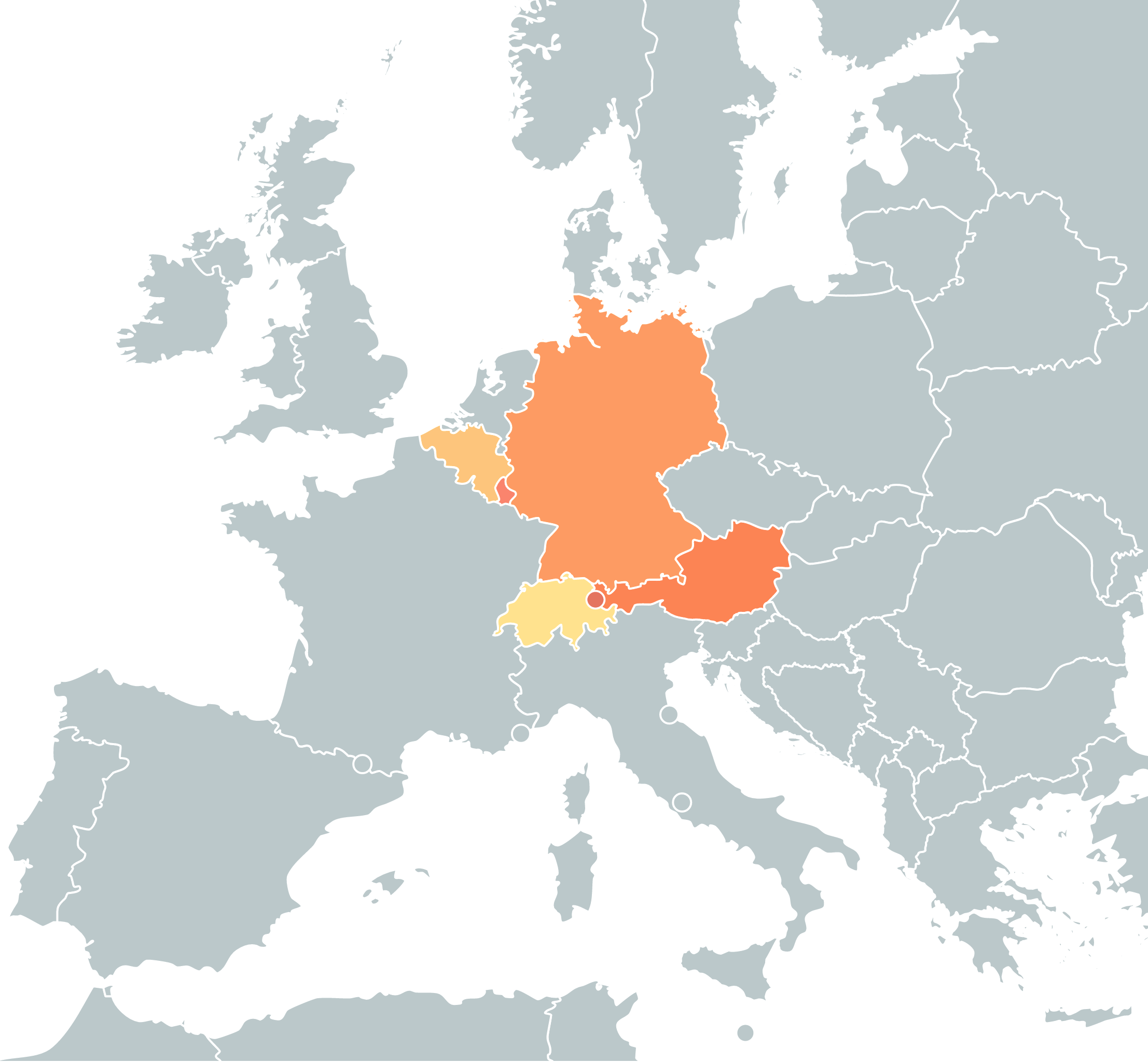|
Udders
An udder is an organ formed of two or four mammary glands on the females of dairy animals and ruminants such as cattle, goats, and sheep. An udder is equivalent to the breast in primates and elephantine pachyderms. The udder is a single mass hanging beneath the animal, consisting of pairs of mammary glands with protruding teats. In cattle and camels, there are normally two pairs, in sheep, goats and deer, there is one pair, and in some animals, there are many pairs. In animals with udders, the mammary glands develop on the milk line near the groin, and mammary glands that develop on the chest (such as in humans and apes and elephants) are generally referred to as breasts. Udder care and hygiene in cows is important in milking, aiding uninterrupted and untainted milk production, and preventing mastitis. Products exist to soothe the chapped skin of the udder. This helps prevent bacterial infection, and reduces irritation during milking by the cups, and so the cow is less likely to ... [...More Info...] [...Related Items...] OR: [Wikipedia] [Google] [Baidu] |
Teat
A teat is the projection from the mammary glands of mammals from which milk flows or is ejected for the purpose of feeding young. In many mammals the teat projects from the udder. The number of teats varies by mammalian species and often corresponds to the average litter size for that animal. In some cases, the teats of female animals are milked for the purpose of human consumption. The quality of some domesticated animals is determined by the establishment of desired characteristics, such as teat size and placement. Number and positioning in animals The number and positioning of mammary glands and teats varies widely among mammals. The protruding teats and accompanying glands can be located anywhere along the two milk lines. In general most mammals develop mammary glands in pairs along these lines, with a number approximating the number of young typically birthed at a time. The number of teats varies from 2 (in elephants and anthropoids) to 18 (in pigs). Marsupials usually ... [...More Info...] [...Related Items...] OR: [Wikipedia] [Google] [Baidu] |
Mammary Gland
A mammary gland is an exocrine gland in humans and other mammals that produces milk to feed young offspring. Mammals get their name from the Latin word ''mamma'', "breast". The mammary glands are arranged in organs such as the breasts in primates (for example, humans and chimpanzees), the udder in ruminants (for example, cows, goats, sheep, and deer), and the dugs of other animals (for example, dogs and cats). Lactorrhea, the occasional production of milk by the glands, can occur in any mammal, but in most mammals, lactation, the production of enough milk for nursing, occurs only in phenotypic females who have gestated in recent months or years. It is directed by hormonal guidance from sex steroids. In a few mammalian species, male lactation can occur. With humans, male lactation can occur only under specific circumstances. Mammals are divided into 3 groups: prototherians, metatherians, and eutherians. In the case of prototherians, both males and females have functional ... [...More Info...] [...Related Items...] OR: [Wikipedia] [Google] [Baidu] |
Cow Udders02
Cattle (''Bos taurus'') are large, domesticated, cloven-hooved, herbivores. They are a prominent modern member of the subfamily Bovinae and the most widespread species of the genus '' Bos''. Adult females are referred to as cows and adult males are referred to as bulls. Cattle are commonly raised as livestock for meat (beef or veal, see beef cattle), for milk (see dairy cattle), and for hides, which are used to make leather. They are used as riding animals and draft animals ( oxen or bullocks, which pull carts, plows and other implements). Another product of cattle is their dung, which can be used to create manure or fuel. In some regions, such as parts of India, cattle have significant religious significance. Cattle, mostly small breeds such as the Miniature Zebu, are also kept as pets. Different types of cattle are common to different geographic areas. Taurine cattle are found primarily in Europe and temperate areas of Asia, the Americas, and Australia. Zebus (also c ... [...More Info...] [...Related Items...] OR: [Wikipedia] [Google] [Baidu] |
Middle English
Middle English (abbreviated to ME) is a form of the English language that was spoken after the Norman conquest of 1066, until the late 15th century. The English language underwent distinct variations and developments following the Old English period. Scholarly opinion varies, but the '' Oxford English Dictionary'' specifies the period when Middle English was spoken as being from 1150 to 1500. This stage of the development of the English language roughly followed the High to the Late Middle Ages. Middle English saw significant changes to its vocabulary, grammar, pronunciation, and orthography. Writing conventions during the Middle English period varied widely. Examples of writing from this period that have survived show extensive regional variation. The more standardized Old English language became fragmented, localized, and was, for the most part, being improvised. By the end of the period (about 1470) and aided by the invention of the printing press by Johannes Gutenberg in ... [...More Info...] [...Related Items...] OR: [Wikipedia] [Google] [Baidu] |
Latin
Latin (, or , ) is a classical language belonging to the Italic branch of the Indo-European languages. Latin was originally a dialect spoken in the lower Tiber area (then known as Latium) around present-day Rome, but through the power of the Roman Republic it became the dominant language in the Italian region and subsequently throughout the Roman Empire. Even after the fall of Western Rome, Latin remained the common language of international communication, science, scholarship and academia in Europe until well into the 18th century, when other regional vernaculars (including its own descendants, the Romance languages) supplanted it in common academic and political usage, and it eventually became a dead language in the modern linguistic definition. Latin is a highly inflected language, with three distinct genders (masculine, feminine, and neuter), six or seven noun cases (nominative, accusative, genitive, dative, ablative, and vocative), five declensions, four ... [...More Info...] [...Related Items...] OR: [Wikipedia] [Google] [Baidu] |
Ancient Greek
Ancient Greek includes the forms of the Greek language used in ancient Greece and the ancient world from around 1500 BC to 300 BC. It is often roughly divided into the following periods: Mycenaean Greek (), Dark Ages (), the Archaic period (), and the Classical period (). Ancient Greek was the language of Homer and of fifth-century Athenian historians, playwrights, and philosophers. It has contributed many words to English vocabulary and has been a standard subject of study in educational institutions of the Western world since the Renaissance. This article primarily contains information about the Epic and Classical periods of the language. From the Hellenistic period (), Ancient Greek was followed by Koine Greek, which is regarded as a separate historical stage, although its earliest form closely resembles Attic Greek and its latest form approaches Medieval Greek. There were several regional dialects of Ancient Greek, of which Attic Greek developed into Koi ... [...More Info...] [...Related Items...] OR: [Wikipedia] [Google] [Baidu] |
Vedic Sanskrit
Vedic Sanskrit was an ancient language of the Indo-Aryan subgroup of the Indo-European language family. It is attested in the Vedas and related literature compiled over the period of the mid- 2nd to mid-1st millennium BCE. It was orally preserved, predating the advent of writing by several centuries. Extensive ancient literature in the Vedic Sanskrit language has survived into the modern era, and this has been a major source of information for reconstructing Proto-Indo-European and Proto-Indo-Iranian history. In the pre-historic era, Proto-Indo-Iranian split into Proto-Iranian and Proto-Indo-Aryan and the two languages evolved independently of each other. History Prehistoric derivation The separation of Proto-Indo-Iranian language into Proto-Iranian and Proto-Indo-Aryan is estimated, on linguistic grounds, to have occurred around or before 1800 BCE. The date of composition of the oldest hymns of the Rigveda is vague at best, generally estimated to roughly 1500 BCE. Bo ... [...More Info...] [...Related Items...] OR: [Wikipedia] [Google] [Baidu] |
Icelandic Language
Icelandic (; is, íslenska, link=no ) is a North Germanic language spoken by about 314,000 people, the vast majority of whom live in Iceland, where it is the national language. Due to being a West Scandinavian language, it is most closely related to Faroese, western Norwegian dialects, and the extinct language, Norn. The language is more conservative than most other Germanic languages. While most of them have greatly reduced levels of inflection (particularly noun declension), Icelandic retains a four-case synthetic grammar (comparable to German, though considerably more conservative and synthetic) and is distinguished by a wide assortment of irregular declensions. Icelandic vocabulary is also deeply conservative, with the country's language regulator maintaining an active policy of coining terms based on older Icelandic words rather than directly taking in loanwords from other languages. Since the written language has not changed much, Icelandic speakers can read cla ... [...More Info...] [...Related Items...] OR: [Wikipedia] [Google] [Baidu] |
Swedish Language
Swedish ( ) is a North Germanic language spoken predominantly in Sweden and in parts of Finland. It has at least 10 million native speakers, the fourth most spoken Germanic language and the first among any other of its type in the Nordic countries overall. Swedish, like the other Nordic languages, is a descendant of Old Norse, the common language of the Germanic peoples living in Scandinavia during the Viking Era. It is largely mutually intelligible with Norwegian and Danish, although the degree of mutual intelligibility is largely dependent on the dialect and accent of the speaker. Written Norwegian and Danish are usually more easily understood by Swedish speakers than the spoken languages, due to the differences in tone, accent, and intonation. Standard Swedish, spoken by most Swedes, is the national language that evolved from the Central Swedish dialects in the 19th century and was well established by the beginning of the 20th century. While distinct regional v ... [...More Info...] [...Related Items...] OR: [Wikipedia] [Google] [Baidu] |
German Language
German ( ) is a West Germanic language mainly spoken in Central Europe. It is the most widely spoken and official or co-official language in Germany, Austria, Switzerland, Liechtenstein, and the Italian province of South Tyrol. It is also a co-official language of Luxembourg and Belgium, as well as a national language in Namibia. Outside Germany, it is also spoken by German communities in France ( Bas-Rhin), Czech Republic (North Bohemia), Poland ( Upper Silesia), Slovakia (Bratislava Region), and Hungary ( Sopron). German is most similar to other languages within the West Germanic language branch, including Afrikaans, Dutch, English, the Frisian languages, Low German, Luxembourgish, Scots, and Yiddish. It also contains close similarities in vocabulary to some languages in the North Germanic group, such as Danish, Norwegian, and Swedish. German is the second most widely spoken Germanic language after English, which is also a West Germanic language. German ... [...More Info...] [...Related Items...] OR: [Wikipedia] [Google] [Baidu] |
Dutch Language
Dutch ( ) is a West Germanic language spoken by about 25 million people as a first language and 5 million as a second language. It is the third most widely spoken Germanic language, after its close relatives German and English. '' Afrikaans'' is a separate but somewhat mutually intelligible daughter languageAfrikaans is a daughter language of Dutch; see , , , , , . Afrikaans was historically called Cape Dutch; see , , , , , . Afrikaans is rooted in 17th-century dialects of Dutch; see , , , . Afrikaans is variously described as a creole, a partially creolised language, or a deviant variety of Dutch; see . spoken, to some degree, by at least 16 million people, mainly in South Africa and Namibia, evolving from the Cape Dutch dialects of Southern Africa. The dialects used in Belgium (including Flemish) and in Suriname, meanwhile, are all guided by the Dutch Language Union. In Europe, most of the population of the Netherlands (where it is the only official language sp ... [...More Info...] [...Related Items...] OR: [Wikipedia] [Google] [Baidu] |








